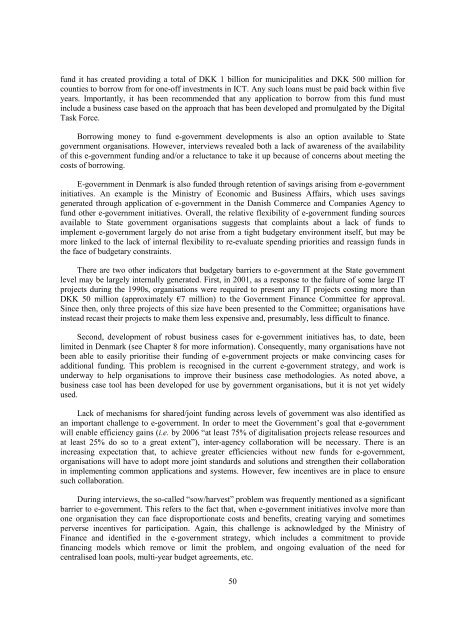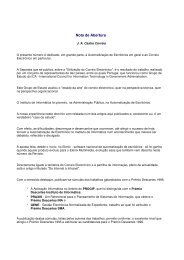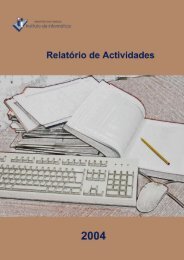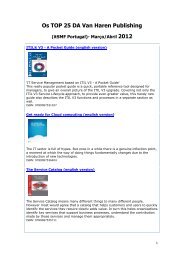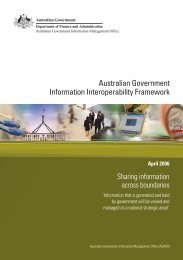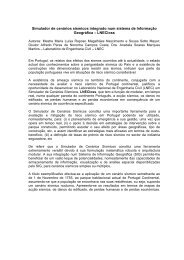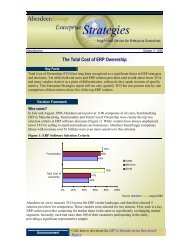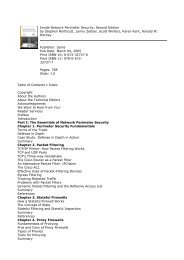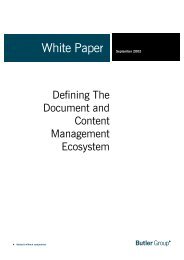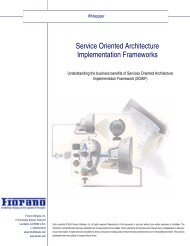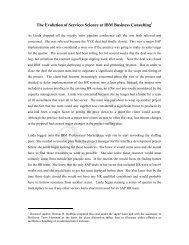OECD Peer Review of E-Government in Denmark - ePractice.eu
OECD Peer Review of E-Government in Denmark - ePractice.eu
OECD Peer Review of E-Government in Denmark - ePractice.eu
Create successful ePaper yourself
Turn your PDF publications into a flip-book with our unique Google optimized e-Paper software.
fund it has created provid<strong>in</strong>g a total <strong>of</strong> DKK 1 billion for municipalities and DKK 500 million for<br />
counties to borrow from for one-<strong>of</strong>f <strong>in</strong>vestments <strong>in</strong> ICT. Any such loans must be paid back with<strong>in</strong> five<br />
years. Importantly, it has been recommended that any application to borrow from this fund must<br />
<strong>in</strong>clude a bus<strong>in</strong>ess case based on the approach that has been developed and promulgated by the Digital<br />
Task Force.<br />
Borrow<strong>in</strong>g money to fund e-government developments is also an option available to State<br />
government organisations. However, <strong>in</strong>terviews revealed both a lack <strong>of</strong> awareness <strong>of</strong> the availability<br />
<strong>of</strong> this e-government fund<strong>in</strong>g and/or a reluctance to take it up because <strong>of</strong> concerns about meet<strong>in</strong>g the<br />
costs <strong>of</strong> borrow<strong>in</strong>g.<br />
E-government <strong>in</strong> <strong>Denmark</strong> is also funded through retention <strong>of</strong> sav<strong>in</strong>gs aris<strong>in</strong>g from e-government<br />
<strong>in</strong>itiatives. An example is the M<strong>in</strong>istry <strong>of</strong> Economic and Bus<strong>in</strong>ess Affairs, which uses sav<strong>in</strong>gs<br />
generated through application <strong>of</strong> e-government <strong>in</strong> the Danish Commerce and Companies Agency to<br />
fund other e-government <strong>in</strong>itiatives. Overall, the relative flexibility <strong>of</strong> e-government fund<strong>in</strong>g sources<br />
available to State government organisations suggests that compla<strong>in</strong>ts about a lack <strong>of</strong> funds to<br />
implement e-government largely do not arise from a tight budgetary environment itself, but may be<br />
more l<strong>in</strong>ked to the lack <strong>of</strong> <strong>in</strong>ternal flexibility to re-evaluate spend<strong>in</strong>g priorities and reassign funds <strong>in</strong><br />
the face <strong>of</strong> budgetary constra<strong>in</strong>ts.<br />
There are two other <strong>in</strong>dicators that budgetary barriers to e-government at the State government<br />
level may be largely <strong>in</strong>ternally generated. First, <strong>in</strong> 2001, as a response to the failure <strong>of</strong> some large IT<br />
projects dur<strong>in</strong>g the 1990s, organisations were required to present any IT projects cost<strong>in</strong>g more than<br />
DKK 50 million (approximately €7 million) to the <strong>Government</strong> F<strong>in</strong>ance Committee for approval.<br />
S<strong>in</strong>ce then, only three projects <strong>of</strong> this size have been presented to the Committee; organisations have<br />
<strong>in</strong>stead recast their projects to make them less expensive and, presumably, less difficult to f<strong>in</strong>ance.<br />
Second, development <strong>of</strong> robust bus<strong>in</strong>ess cases for e-government <strong>in</strong>itiatives has, to date, been<br />
limited <strong>in</strong> <strong>Denmark</strong> (see Chapter 8 for more <strong>in</strong>formation). Consequently, many organisations have not<br />
been able to easily prioritise their fund<strong>in</strong>g <strong>of</strong> e-government projects or make conv<strong>in</strong>c<strong>in</strong>g cases for<br />
additional fund<strong>in</strong>g. This problem is recognised <strong>in</strong> the current e-government strategy, and work is<br />
underway to help organisations to improve their bus<strong>in</strong>ess case methodologies. As noted above, a<br />
bus<strong>in</strong>ess case tool has been developed for use by government organisations, but it is not yet widely<br />
used.<br />
Lack <strong>of</strong> mechanisms for shared/jo<strong>in</strong>t fund<strong>in</strong>g across levels <strong>of</strong> government was also identified as<br />
an important challenge to e-government. In order to meet the <strong>Government</strong>’s goal that e-government<br />
will enable efficiency ga<strong>in</strong>s (i.e. by 2006 “at least 75% <strong>of</strong> digitalisation projects release resources and<br />
at least 25% do so to a great extent”), <strong>in</strong>ter-agency collaboration will be necessary. There is an<br />
<strong>in</strong>creas<strong>in</strong>g expectation that, to achieve greater efficiencies without new funds for e-government,<br />
organisations will have to adopt more jo<strong>in</strong>t standards and solutions and strengthen their collaboration<br />
<strong>in</strong> implement<strong>in</strong>g common applications and systems. However, few <strong>in</strong>centives are <strong>in</strong> place to ensure<br />
such collaboration.<br />
Dur<strong>in</strong>g <strong>in</strong>terviews, the so-called “sow/harvest” problem was frequently mentioned as a significant<br />
barrier to e-government. This refers to the fact that, when e-government <strong>in</strong>itiatives <strong>in</strong>volve more than<br />
one organisation they can face disproportionate costs and benefits, creat<strong>in</strong>g vary<strong>in</strong>g and sometimes<br />
perverse <strong>in</strong>centives for participation. Aga<strong>in</strong>, this challenge is acknowledged by the M<strong>in</strong>istry <strong>of</strong><br />
F<strong>in</strong>ance and identified <strong>in</strong> the e-government strategy, which <strong>in</strong>cludes a commitment to provide<br />
f<strong>in</strong>anc<strong>in</strong>g models which remove or limit the problem, and ongo<strong>in</strong>g evaluation <strong>of</strong> the need for<br />
centralised loan pools, multi-year budget agreements, etc.<br />
50


